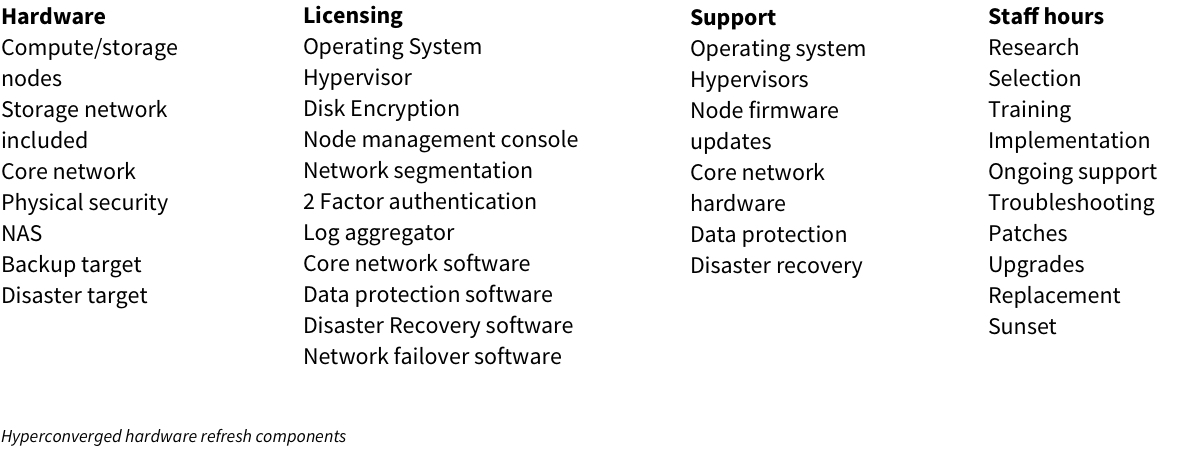Watch the webinar, and, for a deeper dive, read about how to handle your next hardware refresh—if you’re up for it—below the video.
So. You’re due for a hardware refresh in your on-premises or colocated data center.
And, since it’s been what, almost five years since you’ve been through one of these, you’re willing to consider cloud this time around.
With that in mind, it’s probably time to check your math: are you taking into account all the factors you need to be?
Many organizations fail to account for numerous components of the hardware refresh approach: licensing, maintenance, security posture, interoperability, and the impact on staff time spent on week-in week-out maintenance as part of the overall comparison.
Let’s look at the three most common choices: traditional infrastructure, hyperconverged infrastructure, and high-quality VMware-based enterprise cloud service.
Option 1: Traditional infrastructure
At first glance, a traditional infrastructure refresh seems relatively simple: host servers, storage systems, core network, data protection, and all the software licensing needed to run it.
But diving deeper into each category reveals hidden complexity. Choices on hardware platforms for servers and SANs are more diverse than ever. Core network speed expectations are rising. Data protection technologies now need to be ransomware resistant. Security options to protect client data have become requirements rather than options. Here’s an expanded list of components that make up the five categories:

As you can see, the complexity is significant.
Option 2: Hyperconverged infrastructure
In recent years, traditional hardware infrastructure has given up market share to hyperconverged hardware and software implementations. These platforms include many hardware and software components bundled in a simpler offering. Some of the hyperconverged options tout cloudlike capabilities like scale-out, zero downtime maintenance, and lower management overhead. And although it seems like the list of components should be simpler, it still holds complexity:

Capacity planning seems like it should be easier with hyperconverged. It can be harder. If you need storage, you must buy compute power, whether you need it or not. If you need more compute power, you must buy more storage. Since hyperconverged management software resides and depends on the production processors, memory, and storage, sizing for growth often forces you into difficult estimating exercises, and many times you need to overbuy hardware to achieve desired results.
Refresh dirty little secret 1: Interoperability
With traditional infrastructure, making sure that all components work well together is critical. This is usually an exercise in studying hardware compatibility lists and using anecdotal evidence from the service providers. Performance issues often don’t surface until the hardware is in place and in testing or production.
Hyperconverged infrastructure delivers less risk of interoperability problems, as the hyperconverged components were designed together. But they still need to play well with the other components like core networks and data protection technologies. Again, these interoperability and performance issues often don’t surface until the hardware is in place and in testing or production.
Refresh dirty little secret 2: Time
With both a traditional and hyperconverged hardware refresh, the dirty little secret is staff time required to select, train, implement, test, maintain, troubleshoot, and ultimately replace the components. Time spent by IT staff is rarely accounted for. I’ve seen extreme cases where the time spent is underestimated by a factor of 10. Even if you believe that staff IT time is a sunk cost, have you considered which projects the IT staff must forego due to the time investment in all the steps of a traditional or hyperconverged infrastructure refresh?
Option 3: Enterprise Cloud
Maybe it’s time to consider an alternative to a traditional or hyperconverged hardware refresh. But what’s the most practical cloud type to consider?
A well-designed VMware-based enterprise cloud is the best choice for many organizations:
- Familiar surroundings – VMware, the industry-standard hypervisor, is familiar to IT staff members and to the applications that run on it.
- Resiliency in the hardware layer – Just like traditional or hyperconverged hardware, the best enterprise clouds offer redundant servers, storage, and network paths so that no single failure causes an outage.
- Leverage existing skillsets – Many of your organization’s mission-critical applications like ERP systems, electronic medical records, and service management systems are not cloud native, meaning these applications do not have built-in awareness of hyperscale clouds like AWS and Azure. And because hyperscale clouds are built differently than traditional or hyperconverged, the IT staff has to learn completely new skillsets
- Interoperability – The best enterprise cloud providers are constantly testing, assuring, and researching hardware and software options to make sure that the infrastructure is the best it can be.
- No oversubscription - The leading enterprise cloud providers do not oversubscribe their hardware across multiple clients, so that performance stays high and reliable regardless of “noisy neighbors.”
- Manage a service level, not a technology – Enterprise cloud providers are constantly on the hunt for new technologies to improve client experiences. The best providers evaluate servers, storage, network, management software, and connectivity options to help clients maintain the highest service levels possible without having to spend the time on research, selection, training, implementation, maintenance, and troubleshooting.
Using enterprise cloud and thereby consuming infrastructure as a service (IaaS) is a radical simplification compared to traditional and hyperconverged infrastructure. Need more storage? Buy just what you need with no extra time spent on research and no interoperability issues.
Organizations that have made the switch from hardware to enterprise cloud can drastically reduce the keep-the-lights-on maintenance hours spent on infrastructure, freeing them up to focus on improving business applications, driving revenue, opening new lines of business, and reducing costs.
Great enterprise cloud providers offer default security options that, on their own, would be expensive and difficult to maintain. Here, though, you can reduce risk without a collateral time investment.
And because enterprise cloud IaaS is delivered as a monthly operating expense, costs of changes to the business environment can easily be assigned.
Interested in a sensible comparison model for evaluating one more hardware refresh against enterprise cloud? Let’s talk.
